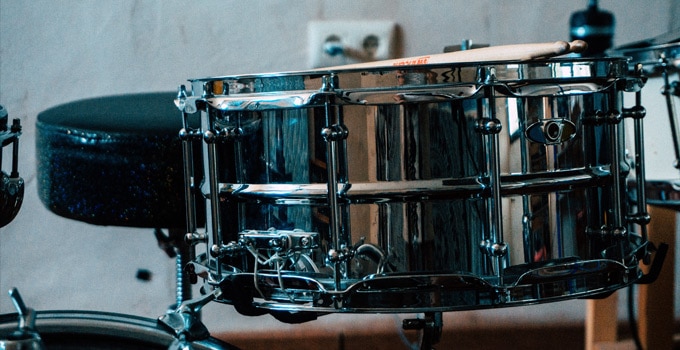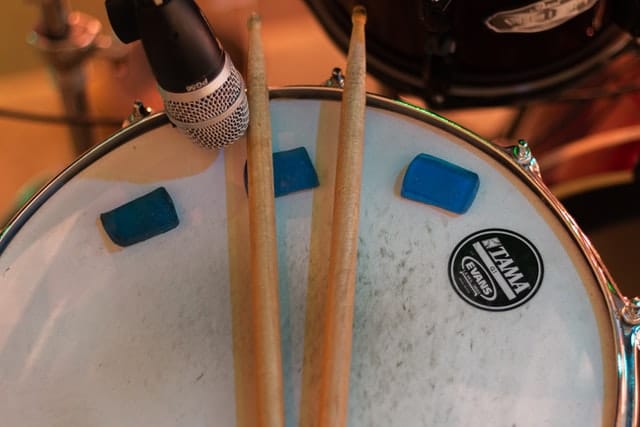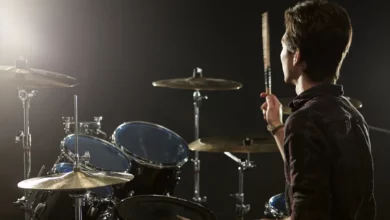
We may earn a commission from the affiliate links on this site. Learn more›
By Matty Allen
If you’re a drum set player, then you know how vital your snare drum is to your artistic voice. Ideally, when you’re preparing to perform or record, you spend a substantial amount of time dialing in the sound of your snare through a combination of painstaking trial and error, watching YouTube tutorials, and blood sacrific…. *ahem* …I mean methodically pitch matching the lugs.
Unfortunately, sometimes you don’t have the opportunity to go through this process.
Maybe you’re playing on a weather-worn house kit, and you forgot to bring your snare. Perhaps you did bring your snare, but the head breaks during soundcheck, so you have to change it 15 minutes before the show.
How To Dampen a Snare Drum Properly
Even if you are using a well-tuned drum, you may want some dampening to achieve a specific sound character. Or additionally, maybe you want to change the way your snare drum sounds mid-set, and you need a quick and easy way to achieve this.
Whatever your reason, we’re here to help you achieve the right sound. Here are ten different ways for you to control the sound of your snare drum on the go.
1. Wallet
Using your wallet as a snare mute is a classic choice for last-minute drum dampening. It provides just enough weight to remove some unwanted ring, but not so much that it completely deadens the acoustic colors of the shell.
Be careful where you place it, though, especially if you’re busting out some fancy crossovers. Hitting your wallet with your stick mid fill can be a death sentence to your flow.
Pros
- Readily Available
Cons
- Increases the chance of forgetting your wallet at the gig
- Effectiveness varies depending on how many paying gigs you had earlier that week.
2. Phone
Do you fancy yourself as a risk-taker? If so, your smartphone is the perfect snare mute for you! Its effect is similar to that of the wallet: It cuts out a few of the overtones while still allowing an excellent stick rebound and a resonant sound. Be sure to switch it to silent mode, though!
Editor’s Note: Nick here. I actually cracked my phone screen doing this. Be extremely careful if you decide to use your phone. Make sure it’s in a case, and I’d even turn it upside down. We are not responsible if you break your screen!
Pros
- You can look at your metronome app to check tempos in the middle of the gig.
- You can check your DM’s in the middle of the concert!
- You have an excuse to get a new cell phone when you inevitably destroy it with a poorly aimed rim shot.
Cons
- Do you NEED a new cell phone, though? Save that money for more important things like drum gear!
3. Moongels/Drum Dots

These handy little gummies are an industry standard and a classic choice for session players.
They will stick to virtually any surface and preserve the drum’s natural resonance more than any other method on this list. They are small and inconspicuous and will rarely get in your way.
Pros
- Looks more professional than a wallet
- Cuts unpleasant overtones without sacrificing resonance
Cons
- If you leave them on your drum, they collect dust and look disgusting after about a week.
- Easy to lose.
4. Sticky Hands
I have to be honest. Sticky Hands are probably my favorite item on the list. I’m talking about those vending machine toys on an elastic string that you used to swat at the window when you were a little kid.
Sticky hands are similar to Moongels, but they are an objectively more fun option.
Pros
- Cheaper than drum dots and Moongels.
- Fun shapes and colors!
Cons
- Due to the decline in shopping malls and gumball machines, these are increasingly difficult to find.
5. Tape
I never show up to a gig without a roll of tape. It is one of the most effective dampening tools in the business.
For best results, I strongly recommend using gaffer tape as it will usually not leave a sticky residue on the drum head, and it will look vastly more legitimate than duct tape or masking tape.
Place small strips of tape near the edge of the drum head as a substitute for moon gels, or outline a square for a more muffled sound.
Pros
- Multifunctional; handy to have with you for on stage
- Gaff tape allows for various levels of acoustic control.
Cons
- Can create a buzzing sound in close mics if the adhesive wears off.
6. T-Shirt or Handkerchief
My high school percussion teacher may have been the first person to teach me about using a cloth to dampen a snare drum, but when I saw Theo Katzman use this technique in Vulfpeck’s music video for the song “1612“ my life was forever changed.
The sound was somehow delicate and soft, yet punchy and funky at the same time! Using a T-shirt is a technique to use if you want that over-compressed and ultra controlled vintage tone.
Pros
- Sounds fantastic in a low volume funk setting.
- Cuts aggressive high frequencies, making it an ideal choice for smaller venues.
Cons
- You probably don’t want to use your favorite shirt for this… or any other shirt that you don’t want full of holes.
- Say goodbye to all of your flashy rebound based licks. This method sucks nearly all of the bounce out of the drum.
7. Splash Cymbal
Using a splash cymbal as a mute is a niche choice that opens up a lot of really cool and creative orchestration possibilities.
This technique is typically used by Drum n’ Bass and Hip Hop drummers who want that crisp and snappy tone.
Pros
- Playing on the cymbal itself offers a unique industrial-sounding alternative to the hi-hat.
- Looks aggressively cool.
Cons
- Prevents you from using your splash cymbal to make splashes.
8. Old Drum Head
Not sure what to do with your old drum heads? Why not upcycle them from trash to treasure! Simply take scissors and cut off the metal rim and… voila! Read my DIY guide here for more info.
You have just made yourself a free ‘Big Fat Snare Drum‘ style drum mute. Much like the branded version, this muffler will give you a delightfully punchy and hyper-compressed e-drum tone.
Pros
- You can also doodle on it with sharpies to create cool custom designs!
- Reduce, reuse, recycle dude.
Cons
- Results may vary depending on how warped the drum head is when you change it.
- Noticeable reduction in rebound. You can mitigate this by cutting a donut shape instead of a filled circle.
9. Coffee Mug
The coffee mug, much like the splash cymbal, creates a tight and snappy sound, and (if you’re careful) it adds a new unique sounding playing surface.
Pros
- A bold statement about your commitment to caffeine.
- The mug provides quick and easy access to beverages during rehearsals and shows.
Cons
- You may have just permanently branded yourself as a hipster.
10. Stuffed Animal
Do you have any old Beanie Babies laying around the house? Chances are, they’re worthless now. Why not try one on your snare? Seriously though, why don’t more people use this one?
Pros
- Effective.
- Adorable.
- Shows your sensitive side.
Cons
- People may question your maturity and sanity, but you should never let that stop you from chasing your dreams!
Got additional suggestions for snare drum muting methods? Let us know down in the comments!
Follow Matt on Instagram: @mattplaydrum







